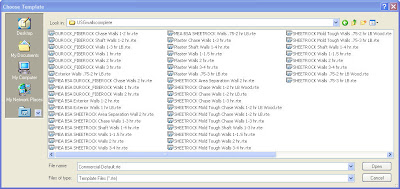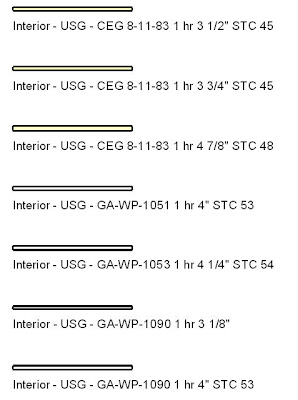Are you trying to set up Revit Architecture for your company? If so, creating wall families can be a time consuming part of your task. I have a possible short cut for you. USG's web site has lots of walls, acoustical ceilings, and custom ceilings available for you to download. They have created just about their entire library of walls and ceilings in Revit format that you can download for free.


This brings up a good topic to discuss... How are you creating wall libraries? I have worked with several firms that are trying to tackle this issue. Your first thought might be to simply load them into your standard template. That is okay if you don't mind working in a large template with extra families that may never be used. Walls are project created families. You cannot have external files of walls like you do for other families (i.e. doors, windows, furniture.) I have found that the easiest way to have a library of walls is to create a separate project that is stored on your network that has nothing but wall families created in it. Users can open this project and find the wall they want to use and simply use the Copy/Paste command to copy the wall to their current project. I would create a view in this "wall project" that lists all the walls in an order that everybody understands. It could be similar to the way USG has created their files, as shown below.

I think manufacturers are finally realizing that Revit is here, and here to stay. I look forward to other companies making Revit content available in addition to the standard .dwg format. But until all manufacturers grasp this concept, you can continue to use my two favorite web sites to grab content for your project. If you have not already, check out Revit City and BIM World. They contain lots of information. Just be careful what you get for free, because sometimes what looks correct is not always the case. For example, I am working with my church to develop plans for a new multi-purpose building, and I downloaded a basketball court to use. Lo and behold, when I pulled down my nifty Graphic Standards, I found that the court was 10' too small.

You can download the entire wall library, or search for a particular wall that meets your needs. Once downloaded, you will see that they are .rvt files (Revit Template files). You can start a new project, and browse to open the particular template that you are looking for. Here is a view of the available wall templates.

This brings up a good topic to discuss... How are you creating wall libraries? I have worked with several firms that are trying to tackle this issue. Your first thought might be to simply load them into your standard template. That is okay if you don't mind working in a large template with extra families that may never be used. Walls are project created families. You cannot have external files of walls like you do for other families (i.e. doors, windows, furniture.) I have found that the easiest way to have a library of walls is to create a separate project that is stored on your network that has nothing but wall families created in it. Users can open this project and find the wall they want to use and simply use the Copy/Paste command to copy the wall to their current project. I would create a view in this "wall project" that lists all the walls in an order that everybody understands. It could be similar to the way USG has created their files, as shown below.

I think manufacturers are finally realizing that Revit is here, and here to stay. I look forward to other companies making Revit content available in addition to the standard .dwg format. But until all manufacturers grasp this concept, you can continue to use my two favorite web sites to grab content for your project. If you have not already, check out Revit City and BIM World. They contain lots of information. Just be careful what you get for free, because sometimes what looks correct is not always the case. For example, I am working with my church to develop plans for a new multi-purpose building, and I downloaded a basketball court to use. Lo and behold, when I pulled down my nifty Graphic Standards, I found that the court was 10' too small.
1 comment:
I believe the floor size of basketball courts is relatively unregulated. You may notice courts seem to vary from gym to gym.
Post a Comment